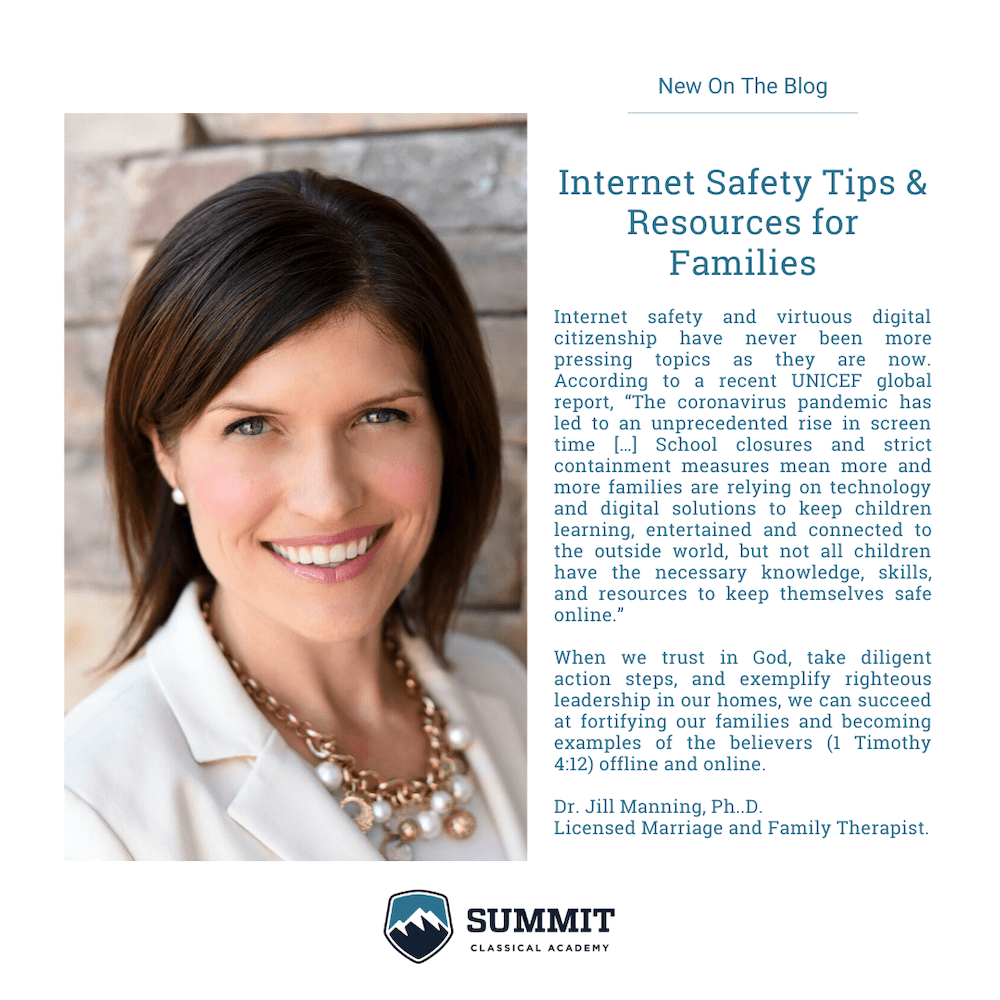Internet safety and virtuous digital citizenship have never been more pressing topics as they are now. According to a recent UNICEF global report, “The coronavirus pandemic has led to an unprecedented rise in screen time […] School closures and strict containment measures mean more and more families are relying on technology and digital solutions to keep children learning, entertained and connected to the outside world, but not all children have the necessary knowledge, skills, and resources to keep themselves safe online.”i
Although digital threats such as Internet pornography, cyberbullying, identify theft, virtual scams, and tech-related addictions abound, Christian families need not despair or feel powerless in the face of these Goliath-like challenges. When we trust in God, take diligent action steps, and exemplify righteous leadership in our homes, we can succeed at fortifying our families and becoming examples of the believers (1 Timothy 4:12) offline and online.
Here are some of my favorite tips and resources for parents, grandparents, and caregivers who are motivated to promote safe and healthy media use in their home:
INTERNET SAFETY TIPS:
1. Openly discuss family standards and expectations related to the amount, the frequency, and the type of media used by family members. Clarifying and teaching the specific family values and gospel principles that align with these standards will help children understand the ‘why’ behind the standard. It is wise to review these standards at least one to three times a year. The beginning of a new school year, the start of summer break, or when facing a new situation (e.g., a state-ordered home quarantine!) are excellent opportunities to discuss how to navigate media use in healthy and safe ways.
2. Model the kind of media use and digital behavior you want your children to live by.
3. Teaching healthy sexuality at home and imparting our values and beliefs about the sanctity of the body, the God-given gift of sexuality, and the nature of healthy relationships provides a powerful anchor and buffer against the lies children will face online. This kind of teaching is most effective when both parents (when possible) are involved and the discussion is layered over time in developmentally appropriate ways.
4. Demystify virtual anonymity by teaching children that nothing we do or say online is truly anonymous or free of consequences. The commandment to love one another applies at all times and in all places, including the virtual world. Conversely, our children need to know that not everyone lives this commandment and that there are people who are not who they appear to be online and who can be cruel and even criminal.
5. Create a simple plan or ‘fire drill’ for how you want family members to respond when they encounter something online that causes them to feel scared, uncomfortable, intensely curious, or hurt. The fire drill can be adapted for different ages and needs. A simple fire drill could be: 1) Shut it off/Turn away, 2) Tell a parent, 3) Decide together how to avoid the content or situation in the future, 4) Pray for help and protection.
6. Share personal examples with our children about how we have dealt with media or Internet dilemmas.
7. Ensure that all Internet-enabled devices have their system updates downloaded and installed. Many system updates include security features, so this can significantly help with Internet security and allow protective settings and filters to work optimally.
8. Activate the parental control features on all Internet-enabled devices, browsers, and apps. For example, Google has SafeSearch, YouTube has Restricted Mode, Sirius XM satellite radio has a feature to block explicit radio channels, Xbox has parental control settings, and Netflix allows you to set and lock the rating limit for specific profiles. Although it is an investment of time to get these features located and activated, they are free tools that add an important layer of protection and peace of mind.
9. Install a filtering system (e.g., Net Nanny, Disney Circle) that allows management of when the Internet is on and off, what type of content is viewed, and ensures all family members are accountable and safe. Check for updates and review the filter settings every other month.
10. If Internet safety is a topic that causes stress or feelings of overwhelm, consider choosing just one thing to implement and then add one tool or approach each month.
INTERNET SAFETY RESOURCES:
CLEAN & SAFE MEDIA PLEDGE FOR FAMILIES: Discussing and signing a media pledge as a family can be a highly effective way to clarify family values related to media use. Posting the signed pledge in a visible area of your home can serve as an ongoing reminder of how your family has decided to use media and why. View the Clean & Safe Media Pledge
SMARTER PARENTING: This website is a parenting goldmine! It provides dozens of lessons, videos, free printables, and ideas for anyone wanting to be a more effective parent. Internet safety is one of many aspects of smart parenting in today’s world, so anything that helps us become more effective parents also helps us better tackle Internet and media issues. Visit Smarter Parenting
EDUCATE EMPOWER KIDS: This group has produced dozens of practical and thought-provoking resources related to Internet safety, pornography, empathy, media literacy, and healthy sexuality. Their 30 Days of Sex Talks series is a staple in my own home, and I highly recommend the free lessons and printables they have created which cover topics such as digital citizenship and social media etiquette. Visit Educate Empower Kids
FBI’S GUIDE TO PROTECTING YOUR KIDS: The FBI provides an excellent online resource for parents interested in protecting their children from a wide range of threats, including abduction, drug use, online predators, cybercrime, social networking sites, and sex offenders. It also includes links to the FBI’s Child ID App. Visit the FBI’s Guide to Protecting Your Kids
COMMON SENSE MEDIA: This group is the leading independent nonprofit organization providing unbiased information and ratings for movies, video games, books, TV shows, apps, and YouTube programs. This site helps families “harness the power of media and technology as a positive force in all kids’ lives.” Visit Common Sense Media
NET NANNY: Net Nanny has long created one of the top-rated filtering and monitoring software programs on the market. Visit Net Nanny
COVENANT EYES: Covenant Eyes is a popular filtering and accountability program. They also provide an impressive array of free resources and e-books pertaining to overcoming pornography problems, including some content for partners of sex addicts. Visit Covenant Eyes
ROUTER LIMITS: A cloud-based router filtering and device management program that provides protection for all internet-enabled devices and not just computers (e.g., smart TVs, phones, gaming consoles, etc.). Visit Router Limits
DISNEY CIRCLE ROUTER FILTER: A popular router filtering and device management program. Disney Circle is a solid option for a whole-home filtering and monitoring system that is user-friendly. Visit Disney Circle Router Filter
i. Children at increased risk of harm online during global COVID-19 pandemic. (15 April 2020). Retrieved from https://www.unicef.org/press-releases/children-increased-risk-harm-online-during-global-covid-19-pandemic.
Dr. Jill Manning is a licensed marriage and family therapist who specializes in working with individuals impacted by compulsive sexual behavior and betrayal trauma in their primary relationship. Over the last twenty years, her work has been featured in numerous peer-reviewed journals, television programs, documentaries, radio shows, and magazine articles, including Oprah Magazine. While serving as a Social Science Fellow at the Heritage Foundation in D.C. in 2005, she was invited to testify before a US Senate sub-committee about the harms of pornography on the family. She currently serves on the Board of Directors for Enough is Enough and the Advisory Council for Fight the New Drug. A native of Calgary, Alberta, Canada, she currently lives in Colorado with her husband and two daughters.





